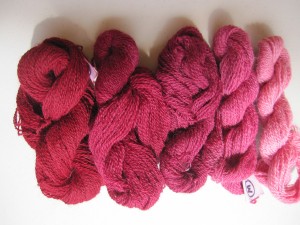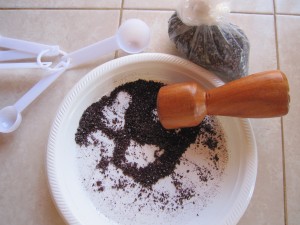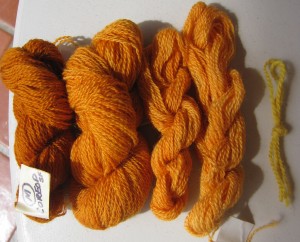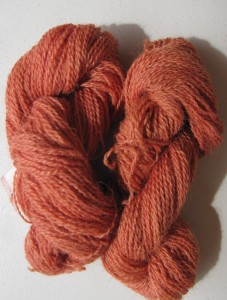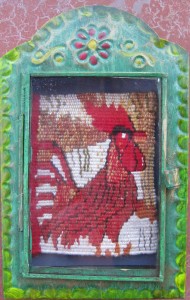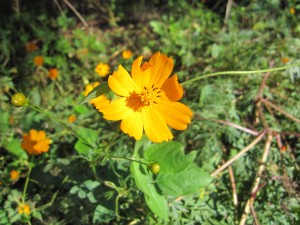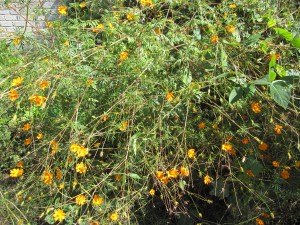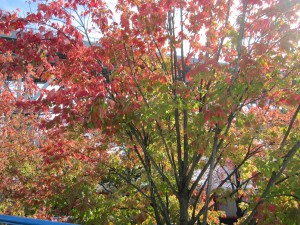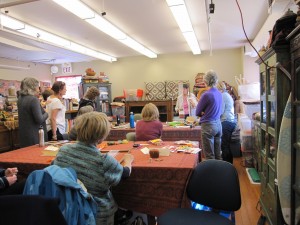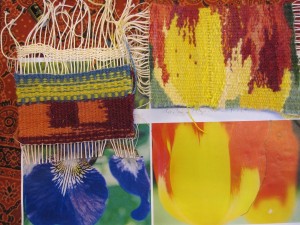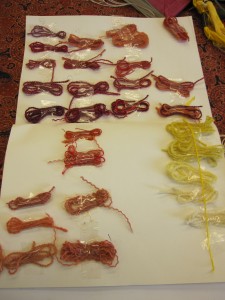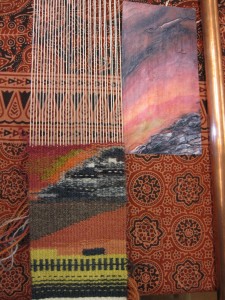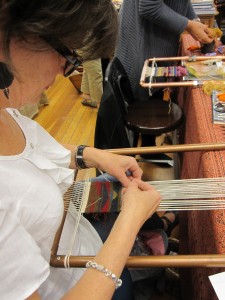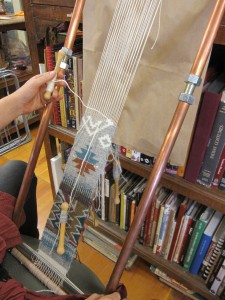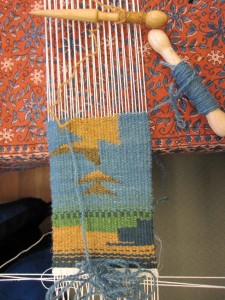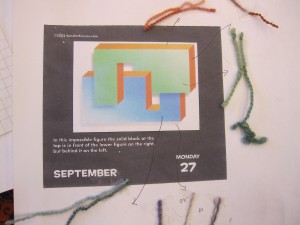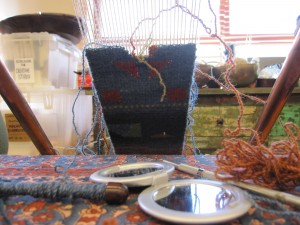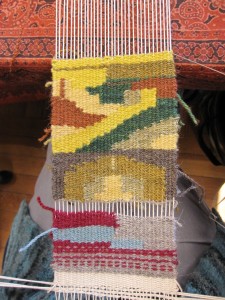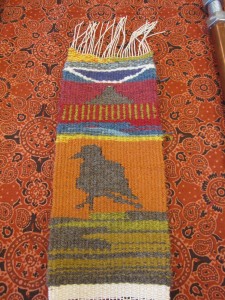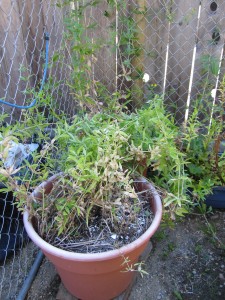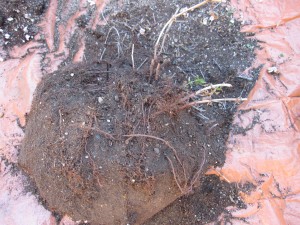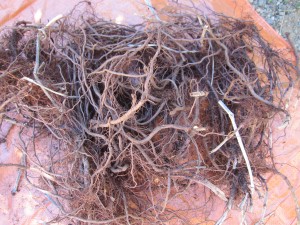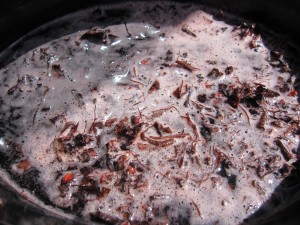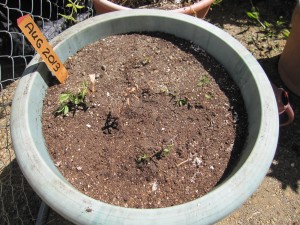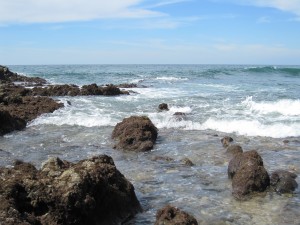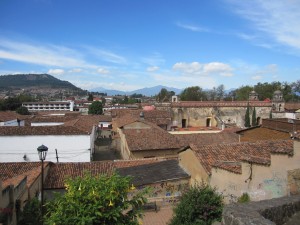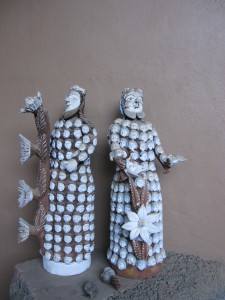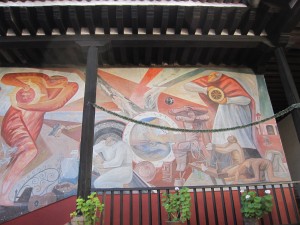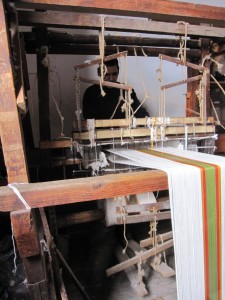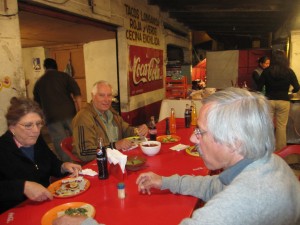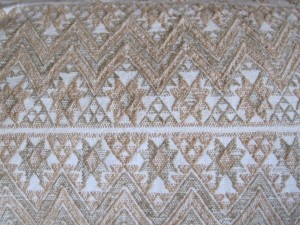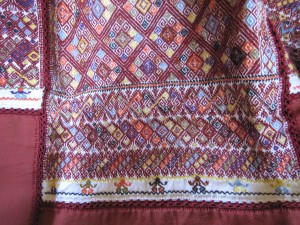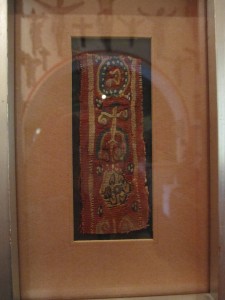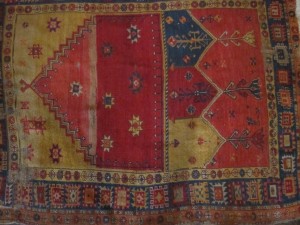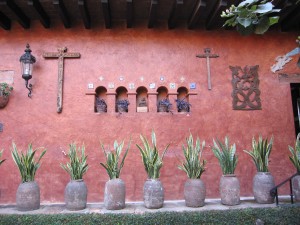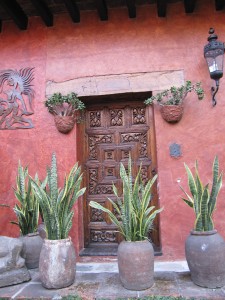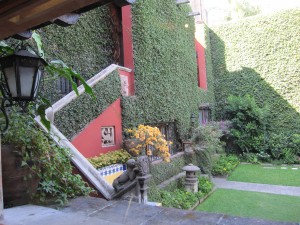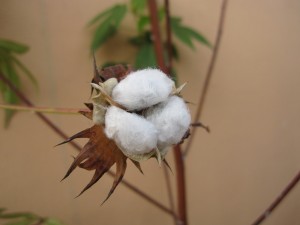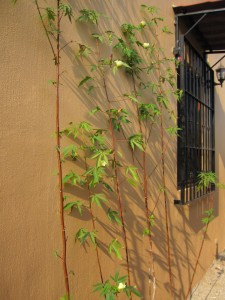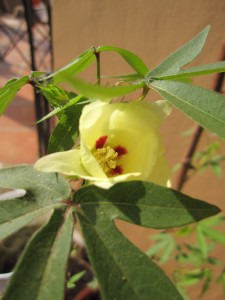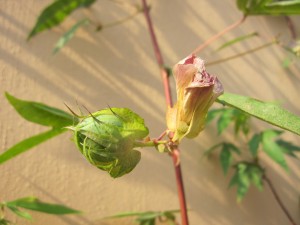Author Archive
Natural Dyeing in Lo de Marcos, Nayarit, Mexico
by Elaine on Feb.25, 2014, under Blog Posts
This year in Lo de Marcos one of my goals was to set up a small natural dye space. I went in search of an oval crock pot and was successful in finding one that had off, warm, low and high temperature choices. And it was also on sale, even better. I had a friend bring me a candy thermometer and timer while she was on a trip to Arizona over Christmas. I had hunted everywhere here and could not find those items. But I did find inexpensive large metal spoons. I asked a friend from Oaxaca to bring me some cochineal bugs and powdered indigo. I found alum (alumbre in espanol) at the hardware store in La Penita. Everything was coming together. I had brought a skein of Pollika Lace bluefaced Leicester which I had purchased at Maiwa before leaving for Mexico. I was interested in how it would take the natural dyes and whether it would be suitable for tapestry.
Since this was an experiment I made the 100 gram skein into small skeins, scoured the skeins, mordanted with alum, and then proceeded to dye the yarns. When it came to using the cochineal, I purchased a wooden pistle for grinding up the bugs.
You can see from the first photo my dyeing with cochineal. I tried to get a variety of shades of the gorgeous fuschia colour those bugs shared.
I also dyed skeins of yarn with an orange blossom from a coreopsis plant which I harvested the first few weeks I was here and I froze the blossoms in preparation for dyeing.
The small piece of wool yarn on the far right in the above photo was non-mordanted and solar dyed.
My last experiment with the dyes was to combine the two dye baths, more coreopis, less cochineal and this was the result. The skeins looked very much like they were dyed with madder.
The rooster finally finds a home
by Elaine on Nov.18, 2013, under Blog Posts
I wove this small rooster in a tapestry workshop taught by Lynne Curran in Santa Fe, New Mexico, in the summer of 2010. It has taken me three years to find the perfect way to hang this little guy….a small metal frame which has a glass door that opens.
Mystery plant for natural dyeing
by Elaine on Nov.18, 2013, under Blog Posts
I have been wandering the roads of Lo de Marcos, my winter home in Nayarit, Mexico in search of dye plants. I came across this plant which has a flower resembling the coreopsis plant. I picked a few blossoms and added hot water and watched a gorgeous orange colour develop. Later I placed a small amount of wool, unmordanted, into the dye water and left in the sun for a few hours. Had a lovely golden yellow develop. Now I am wondering if it is related to the coreopsis family and whether it is lightfast and washfast. Any ideas or thoughts?
Tapestry Weaving at Maiwa Textile Symposium 2013
by Elaine on Oct.14, 2013, under Blog Posts
This past week I had the pleasure of teaching Tapestry at the Maiwa Textile Symposium on Granville Island in Vancouver, BC.
The workshop included students from as far away as Alberta, Victoria, Kamloops as well as Vancouver and the surrounding areas. We met for four days to learn to weave tapestry or to enhance our current skill levels. The participants were keen, asked really good questions and had a spirit of adventure and cooperation. It was a wonderful combination! And also really good energy. We started the class out with warping copper pipe looms using Cotton Seine Twine Finnish #15 at 8 epi, total of 33 threads. For exercises to begin with we played with lines, gradually increasing the number of lines so we had a progression of colour. We practised slit, weft interlock and warp interlock techniques and then started to work on shapes. Everyone had their own ideas and the students were encouraged to follow their hearts and do something they were interested in doing. The students wove with naturally dyed 100% wool 2 ply that was mill spun from Romney sheep. Everyone commented that the natural colours helped to make the choice of colour easy These are some photos of the progress that was made in the course.
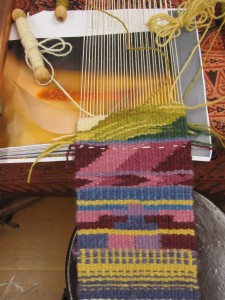
Catherine worked on geometric shapes at first, then chose a photographic image of a flower for her project
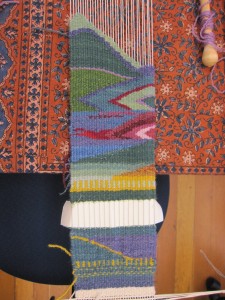
Avyn chose to weave intuitively, letting her mind choose the next step after visually acknowledging what had gone on before
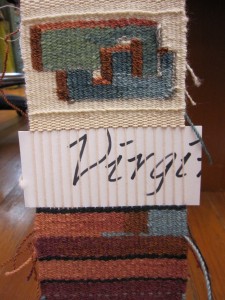
Virginia used traditional French hachures to practise colour blending. She managed to get lots into her 4 inch wide sampler.
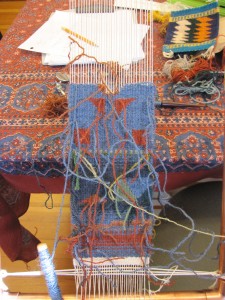
Shannon initially started out weaving from the front, then changed to weaving from the back which she decided was easier for this geometric design.
There are two others from our workshop that I unfortunately do not have photos of…one is Bonnie who arrived each day, bright and cheery, staying to the end. Bonnie had some challenges getting her fingers to work due to some health issues. Her sampler was the smallest, but there was so much positive energy emanating from it. She loved being in the group learning from the others. Thank you Bonnie for being there! The other very important person was Myrna, our workshop assistant. Myrna helped the students with their weavings as well as helping me getting comfortable with the space. Thank you Myrna!
Thank you also to Maiwa which holds a symposium in the fall of each year. It was a pleasure to work with the owner, Charllotte Kwon, and the rest of the staff at Maiwa.
Growing and harvesting madder
by Elaine on Aug.07, 2013, under Blog Posts
It is August and that time of the year to harvest the madder plants to dye a rich orange/red. I use three large tubs and harvest from one tub each summer. This allows the plants to develop large enough roots and provide enough dye on a 3 year cycle. The roots should be about a pencil diameter size for harvesting. Madder plants do not like to be in pots, but I want to take them with me should I decide to move and this seemed like a good way to do it.
Gently remove the soil that surrounds the roots and save a few plants to replace those taken from the current pot. The dirt comes off easily.
After I remove the soil, I cut the roots into small pieces, about 1/8-1/4″ long. I rinse the roots with water to remove any remaining soil and then put the roots in a pot with just enough water to cover them well and slowly raise the temperature to about 180 degrees. Raising the temperature too high will produce a brown colour, not the rich orange/red I am wanting. After an hour or so, I turn the heat off and allow the roots to remain soaking. The next day I drain the dye liquor off and save it. I repeat this process for a total of three times. Saving the dye liquor for dyeing.
Madder likes to have hard water for dyeing. If your water is too soft, you can add a few calcium tablets to the dye bath. I also use ground egg shells on the soil in the pots. The pots do not have to be watered often…a good soaking once a week is lots. I live on Vancouver Island, BC and the winters are conducive for the madder plants to survive easily. The tops can be harvested and can be used separately for another paler shade. I have not tried this yet, but when I do, I will post my results.
You can also grind up the remaining roots in a dedicated-blender and get more dye by soaking, heating and taking the liquor off each time.
Inspiration…where the ocean meets the sky…
by Elaine on Mar.10, 2013, under Blog Posts
South of Lo de Marcos accessible from the beach road, either driving or walking, are two small sandy private beaches, Playa las Minitas and Playa el Venado. I had the privilege of sitting for an afternoon watching the tide come in and splash on the rocks…lots of small tidal pools with wonderful colours, shapes and sizes…great time!
Workshops for 2013
by Elaine on Feb.05, 2013, under Blog Posts
I have listed the workshops I am prepared to teach for 2013 under Tapestry weaving classes and natural dye workshops at the top of the website page. Please contact me if you are interested in attending. Classes do fill up quickly.
I am also available for private sessions as well as willing to travel to give workshops and lectures. Contact me at: elaine@elaineduncan.com .
A two week road trip to Oaxaca, Mexico
by Elaine on Feb.05, 2013, under Blog Posts
On January 11, 2013 we set out on a road trip with our final destination being Oaxaca City, Oaxaca, Mexico and the Textil Museo of Oaxaca where a symposium called Interweaving Cultures: A Meeting was to be held on January 18 and 19th. Jean Pierre Larochette and Yael Lurie came up with the inspiration for this symposium and were joined by members of the American Tapestry Alliance and Zapotec weavers from Teotitlan del Valle.
Our companions for the journey were Larry and Judy Romiti, rug weavers with a business called Romiti Art. Larry generously offered to drive and Judy was the navigator. They live part of the year near Lake Tahoe, Nevada and part of the year here in Lo de Marcos, Nayarit, Mexico.
Our first night’s stop was a lovely small town called Patzcuero. We stayed in a quaint hotel and had a beautiful view of the area.
The 11 Patios contained many doors leading to arts and craft areas…both retail and working spaces.
Our second day of travel took us to friends of Judy and Larry in Cuernava. We were welcomed in true Mexican style and stayed there for two days. Our first full day gave us an opportunity to view a collection of Mexican clothing that was being offered for sale. The pieces were mainly made of cotton, although there was a piece of silk and cotton as well. You can see the detail of the designs in the photos:
The photograph above is of cotton warp and two different cottons for weft…one for the background and one acting as a supplement for the design. All natural coloured cotton.
And another one:
That afternoon we went into downtown Cuernava and walked around the square. We went to the Robert Brady Museo which was his home when he was alive. He collected art from around the world. These are just a few examples:
Of course, I was primarily interested in the textiles he had in his collection. It also turns out he was actually a weaver of rugs and tapestries as well. He had several wonderful rugs from all over the world:
Guess what? cotton bolls have appeared
by Elaine on Dec.20, 2012, under Blog Posts
All of a sudden, earlier this week, we noticed that the bolls of cotton were appearing. Very exciting…they are quite small, so will wait awhile and see if they grow any larger.
Growing cotton in Lo de Marcos, Mexico
by Elaine on Nov.19, 2012, under Blog Posts
Last winter when I was in Mexico, I noticed a cotton plant growing by the side of the road leading to the beach in Lo de Marcos, Nayarit. I picked a few bolls of cotton and discovered the seeds inside as well as a very nice natural white coloured fibre. I planted the seeds and within a few days all four seeds had sprouted. I transplanted the plants, one per pot and when we left in March they were growing nicely. Upon our arrival this November, the plants had grown alot…way over my head and they had lots of flowers on them. The flowers were a creamy white, pale yellow and pink.
We started to water the plants often (every other day) and noticed the leaves were coming back and flowers were prolific. We moved the plants from an outside wall to a wall on the casita as the iguanas had found the leaves were very tasty. Just the other day, I noticed that bolls were forming where the flowers had dropped off.
I will keep updating this post as the cotton bolls grow. I have brought some supported spindles with me to practice spinning some cotton fibre I purchased from Gemini Fibres in Ontario while the cotton bolls are forming. A very good friend gave me the spindles to use and another friend spent an afternoon showing me how to use them!
